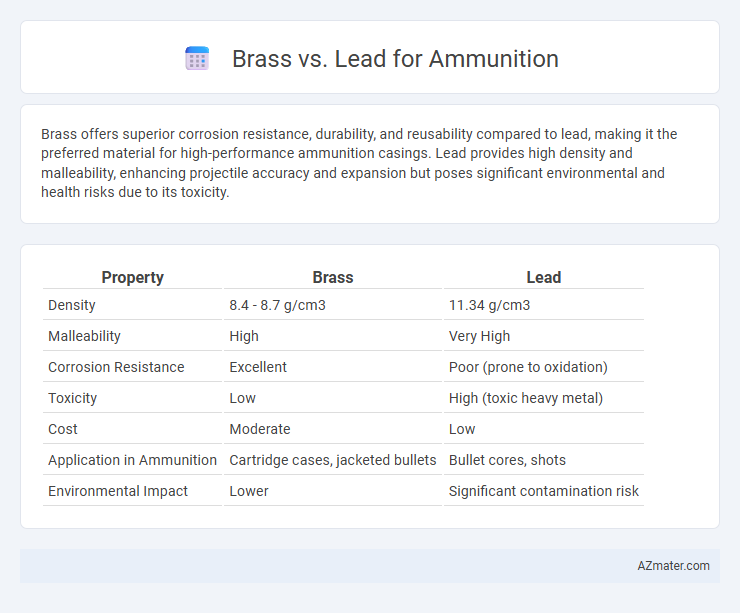Brass offers superior corrosion resistance, durability, and reusability compared to lead, making it the preferred material for high-performance ammunition casings. Lead provides high density and malleability, enhancing projectile accuracy and expansion but poses significant environmental and health risks due to its toxicity.
Table of Comparison
| Property | Brass | Lead |
|---|---|---|
| Density | 8.4 - 8.7 g/cm3 | 11.34 g/cm3 |
| Malleability | High | Very High |
| Corrosion Resistance | Excellent | Poor (prone to oxidation) |
| Toxicity | Low | High (toxic heavy metal) |
| Cost | Moderate | Low |
| Application in Ammunition | Cartridge cases, jacketed bullets | Bullet cores, shots |
| Environmental Impact | Lower | Significant contamination risk |
Introduction to Ammunition Materials
Brass and lead are two primary materials used in ammunition components, each offering distinct advantages in performance and manufacturing. Brass, an alloy of copper and zinc, is commonly utilized for cartridge cases due to its durability, corrosion resistance, and ability to be precisely machined. Lead, a dense and malleable metal, is primarily used in bullet cores and projectiles, providing effective energy transfer and penetration upon impact.
Overview of Brass and Lead in Ammunition
Brass is commonly used for cartridge cases due to its corrosion resistance, malleability, and ability to withstand high pressures during firing, making it ideal for reliable ammunition performance. Lead is primarily utilized in bullet cores and some full metal jacket bullets because of its high density, affordability, and ease of shaping, providing impactful terminal ballistics. The combination of brass casings and lead bullets balances durability, cost-effectiveness, and ballistic efficiency in most modern ammunition types.
Physical Properties: Brass vs Lead
Brass casings offer superior corrosion resistance and higher tensile strength compared to lead, making them more durable and reliable under high-pressure firing conditions. Lead projectiles are denser and softer, providing excellent impact deformation and energy transfer, which enhances terminal ballistics. The combination of brass casings and lead bullets optimizes both structural integrity of the cartridge and effective projectile performance.
Performance Differences in Ballistics
Brass ammunition casings offer superior corrosion resistance and consistent expansion, resulting in better gas seal and pressure retention for improved ballistic performance compared to lead casings. Lead bullets, often used in ammunition, provide higher density, which contributes to greater penetration and energy transfer on impact. The combination of brass cases with lead projectiles typically achieves optimal accuracy and reliable feeding in firearms, balancing durability and ballistic efficiency.
Corrosion Resistance and Durability
Brass casings exhibit superior corrosion resistance compared to lead, making them the preferred choice for long-term ammunition storage and reliability in various environmental conditions. The durability of brass ensures consistent chambering and extraction, reducing the risk of malfunctions during repeated firing cycles. Lead, being softer and more prone to oxidation, tends to degrade faster, which can compromise both the integrity and performance of the ammunition over time.
Environmental Impact and Toxicity
Brass casings, composed primarily of copper and zinc, offer a lower environmental toxicity compared to lead-based ammunition, which releases harmful lead particles that can contaminate soil and water, posing significant risks to wildlife and human health. Lead ammunition fragments degrade slowly, increasing the persistence of toxic substances in the ecosystem, whereas brass casings are more biodegradable and pose less long-term environmental risk. The use of non-toxic brass reduces the likelihood of lead poisoning in scavenger species and contributes to safer shooting ranges and hunting environments.
Cost and Availability Factors
Brass ammunition casings are widely favored for their durability and reusability, but their higher manufacturing costs and fluctuating metal prices make them less affordable than lead alternatives. Lead bullets remain more cost-effective due to lower material expenses and broad availability, especially in regions with extensive lead mining industries. Availability of brass can be constrained by supply chain issues and demand spikes, whereas lead benefits from established, abundant reservoirs and recycling programs, impacting overall ammunition pricing and accessibility.
Reloading and Maintenance Considerations
Brass ammunition cases offer superior durability and can be resized and reload multiple times, making them ideal for frequent reloaders seeking cost efficiency and reliability. Lead cases, commonly used in lower-cost or specialty rounds, generally wear out faster and may require more careful cleaning to prevent fouling and corrosion during repeated use. Proper maintenance of brass involves regular case trimming, annealing, and inspection for cracks, while lead ammunition demands thorough cleaning to remove residue and minimize barrel fouling.
Legal Regulations and Restrictions
Brass ammunition casings are widely accepted and face fewer legal restrictions due to their non-toxic properties, making them compliant with many firearm regulations worldwide. Lead ammunition, however, is often subject to stringent legal restrictions or bans in various regions due to environmental and health concerns related to lead toxicity and contamination. Many countries and states enforce laws limiting or prohibiting the use of lead ammunition, especially in hunting and shooting ranges, to protect wildlife and groundwater from lead exposure.
Choosing the Right Material for Your Ammunition
Selecting the right ammunition material hinges on factors such as reliability, corrosion resistance, and environmental impact. Brass casings offer superior durability, excellent corrosion resistance, and easier reloading, making them the preferred choice for many shooters. Lead ammunition provides cost-effective options but poses environmental and health risks due to toxicity, often restricting its use in regulated shooting areas.

Infographic: Brass vs Lead for Ammunition
 azmater.com
azmater.com